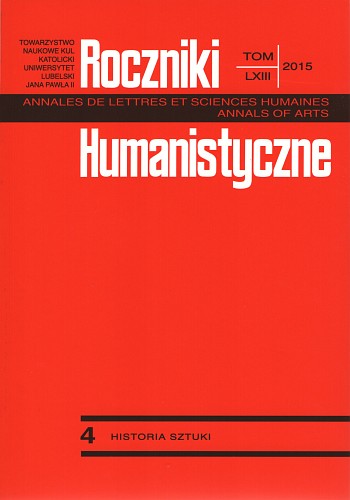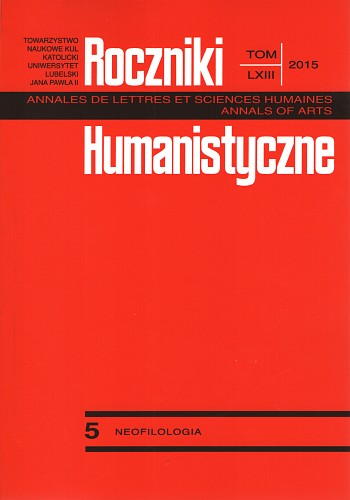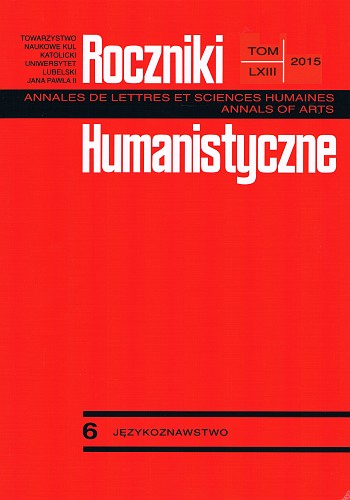

![Giuseppe Capriotti, Lo scorpione sul petto. Iconografía antiebraica tra XV e XVI secolo alla periferia dello stato pontificio, Roma 2014, [seria: Collana Helicona di Monografie di Storia dell’Arte, red. Marco Gallo]](/api/image/getissuecoverimage?id=picture_2015_23230.jpg)

Keywords: connective;French;Polish;enunciative attitude;opposition;contrastive analysis
The French connective mais at the beginning of a reply in a dialogue and its Polish counterpart are regarded as indicating enunciative attitude (attitude énonciative, Anscombre 2009). Analysis shows that in Polish texts an opposed position is frequently strengthened by the addition of several words and the connective ale/ależ at the beginning of a reply is then facultative, or it can be weaker and then other markers (lecz, co tam, co ty, etc.) are decisive for understanding the text. In translating into French, translators often add the word mais at the beginning of a reply. Contrastive analysis showed that the use of mais is much more systematic and general than the Polish words which give varying degrees of complexity at the semantic-pragmatic level.
More...
Keywords: tense;aspect;modality;Portuguese language;Polish language
The aim of this study is to compare the temporal system of the Polish and Portuguese language that is to indicate common and distinguishing features between two above mentioned systems. Therefore firstly it shall be considered how both systems are functioning, secondly the most fundamental criteria of such comparison shall be established. Finally an analysis of temporal values of the particular verbal forms shall be conducted. Furthermore the purpose of this study is to compare means of expression of the temporal category in Polish with means of expression of the temporal category in Portuguese. As a result the study indicated that the temporal category together with category of aspect form interconnected grammatical categories which meet on the functional basis. While in Portuguese time and aspect are expressed by morphemes cumulating both functions, Polish has different means of expression of each of these categories. The study enabled to formulate conclusions regarding similarities and differences between both systems as well as to indicate specific features which emphasize uniqueness of each analyzed system.
More...
Keywords: multilingualism;language policy;European Union;
Multilingualism is a value that the European Union has been protecting and supporting since its creation. The principle of equality of the official languages of the Union becomes the proof of respect that the Community has towards all cultures and national identities of the member-countries citizens. Yet, this value has attracted much criticism. We decided to analyze the phenomenon of multilingualism in the Union, asking after Milian I Massana: is it a myth or reality (2002: 47)?
More...
Keywords: aspect;verb system;compositional nature of aspect;
The main aim of this article is to describe the classical typology of aspectual classes proposed by Vendler (1967). For that reason, the article is devoted to a general study of this classification. The author also reflects on the compositional nature of aspect.
More...
Keywords: Maupassant;Horla;fantastic;fear;insanity;autoscopic;
The Horla, written twice, is considered as a masterpiece of a short horror story. Its two versions are still objects of critics’ arguments : some of them see in the second text an amplified and revised version of the first one, whereas others consider the two texts as two separate stories. The paper tries to consider the two Horlas as two complementary parts of the same story ; the first is told by a completely ‘normal’ person who has asked to live in a lunatic asylum, and the second, full of striking, strong emotions, is given by someone who gives up more and more to mental troubles caused by his fear of the unknown, the unnamed, the invisible. Considered in this way, the texts of the two versions of The Horla become one “autoscopic” story, which means that it is its own reflect; two narrative lines and two different endings deal with two sides, one rational ant the other irrational, of the narrator’s personality. This dualism comes as well from the writer’s biography (his gradual insanity) as from his time’s fascination of mental illnesses and anomalies.
More...
Keywords: Eleonora Kalkowska;Polish-German literature;anti-war poetry;social drama;engaged literature;female literature;
The study devoted to the forgotten Polish-German actress and writer, Eleonora Kalkowska, is a contribution to the reception of her works. The author makes an attempt to order the current state of the research in both Germany and Poland. Consequently, she depicts Kalkowska’s artistic development: from love poetry (Die Oktave, 1912), through anti-war lyrics (Der Rauch des Opfers, 1916), up to social drama of the in-between-the-wars period (Josef, Zeitungsnotitzen, 1932), of which Kalkowska is an eminent representative. Transnational quality of her works has been noticed here, whose most important idea is social justice and defense of humanity. The uniqueness of her writing is characterized by the form and manner of realizing her artistic mission, both from a humanistic, Christian and woman’s perspective.
More...
Keywords: the sacred in literature;novel;Patrick Roth;
The article discusses the novel Corpus Christi, the third part of a literary trilogy by Patrick Roth, a contemporary German writer currently living in Los Angeles. All Roth’s plots focus on human attitudes towards the received message concerning the Messianic Jesus. The author concentrates on the image of Jesus present in the psyche of contemporary people in order to show the process of cognition of spiritual matters. The analysis aims to trace in the novel both biblical references and elements which depict the mystical experience leading to an individual’s spiritual transformation. The novel Corpus Christi, whose very title has theological connotations, features scenes, characters and plot patterns derived from the Bible. they are, however, subject to the author’s innovative modifications. The text contains more references to the transcendental than depictions of the temporal. Both realities are inseparable and intersect. The sacred, which imposes the need for worship and transcends the horizon of the temporal, is shown by means of images deeply rooted in the Judeo-Christian tradition.
More...
Keywords: uncertainty;world-risk-society;Marlene Streeruwitz;Thomas von Steinaecker;
The article discusses contemporary strategies of presenting the global threat in so called global risk society (Ulrich Beck), basing on the novels of Marlene Streeruwitz and Thomas von Steinaecker. Both works may well be interpreted as a thorough diagnosis of both private and social alarmism. Continuous anticipation of threats and a permanent wish to insure against all possible risks limit individual and public freedom, trigger a notion of instability and make citizens become the hostages of insuarance agencies and security companies.
More...





Keywords: the Khakhlak language;Sławatycze;Eda Ostrowska;
Eda Ostrowska’s little dictionary of the Khakhlak language is an article that presents the manuscripts donated to the Library of the Catholic University of Lublin by the author, in an arranged form along with a linguistic commentary. The most numerous group in the dictionary is constituted by nouns, and among them – terms denoting people, names of dishes, of clothes, parts of the body, plants and animals. Another considerably big group is made up by verbs and other parts of speech; there are much fewer phrases, sayings, curses and peculiar sentences heard in the language. The presented material, gathered by a person who was not a specialist and selected the material in a subjective way is characterized by a great emotional charge. The collected material shows a linguistic picture of the world characteristic of the borderland.
More...
Keywords: phraseological fixed phrases;personal names;place names;etymology;syntactic patterns;
This paper focuses on English and Polish fixed phrases involving personal and place names. First, the definition of a name and the distinction between proper and common nouns or proprial lemmas and proper names are provided, following a short overview of theories that constitute the basis for any discussion related to proper names. Next, subcategories and sources of names, together with their linguistic characteristics are presented, followed by the working definition of phraseological fixed units. Afterwards, the study is undertaken of personal and place names in fixed phraseological units, surveying a broad list of English and Polish fixed entities that are classified according to five syntactic patterns: phrases with (1) NPs, (2) VPs, (3) PPs, (4) clauses, and (5) similes. Additionally, the biblical, literary, classical, cultural and historical origins of these expressions are pointed out. Finally, in the light of the examined data, the predominance of personal over place names is noticeable, while the items with NPs constitute the vast majority of the phraseological units. Investigating corpus and dictionary evidence, fixed elements typical either of English or only of Polish, or those common to both English and Polish are listed. The most frequent are the units from biblical and mythological sources, while the least popular are the expressions with historical and literary background, as these aspects are unique for each country. With regard to the meaning of the fixed phrases containing proper personal and place names, the data reveal that the units do convey information, recall connotations that arose some time ago in relation to the biblical, mythological, literary, cultural, and historical background, and are still relevant today.
More...
Keywords: dual number;fifth Latin declension;Latin morphology;
The loss of the dual number in the early pre-literary phase of the development of Latin caused massive changes in the Latin declension. The dual forms of consonant stems, which in animate nouns (later masculine and feminine nouns) were probably characterised by the ending *-ē, gen. du. *-ēs (< PIE nom. du. *-eh1, gen. du. *-eh1s), were generally reinterpreted as plurals (hence the secondary plural ending -ēs < nom. du. *-ē in Latin) and sometimes as collectives or singulars (nom. sg. -ēs < nom. du. *-ē). The latter process led to the formation of the fifth Latin declension with the characteristic -ē-. This category includes very numerous nouns that have no plural forms (singularia tantum). Also the Old Latin dual forms ending in *-ī (< PIE *-ih1) like viginti ‘twenty’ were transformed by regular morphological processes into singulative forms with -iēs, -iēi, which are also in the fifth declension. On the basis of these observations, the author advances the research hypothesis that the fifth Latin declension appeared already in the pre-literary period as a result of the loss of the earlier dual inflection.
More...
Keywords: surnames;compound nicknames;two-word nicknames;anatomical lexis;names of parts of the body;vanishing of names derived from two-word nicknames;
Anthroponyms derived from compound nicknames, that is two-word ones, are the subject of the author’s discussion. The most popular formal type of such nicknames is the compositum consisting of an adjective and a noun; also compounds consisting of a verb and a noun are numerous. The article is concerned with names containing anatomical lexis (e.g. side, eyebrow, beard, belly. The nicknames usually refer to a man’s appearance (Białobroda – Whitebeard, Grzebinoga – Pokeleg), but also to the character, behavior (Bolibrzuch – Belly-ache, Chwaligłówka – Praisehead), job (Golibroda – Shavebeard). Two-word nicknames have a humorous, and sometimes evaluating character. The author also pays attention to the process of the vanishing of names derived from two-word nicknames, especially ones that are definitely negative or vulgar. This is connected with the clarity of their original meaning, and hence with a negative attitude of the bearers towards their own names.
More...
Keywords: civil status;act of knowing;birth certificate;text genre;official style;text pattern;text substitution;French influence;19th century;
The Witness Statement as a genre of official style of a documentary nature has been considered in the article to be old, because its formation was not a long process, lasting in the Polish language from the early 19th century, when it was introduced with the legal regulations of the Napoleonic Code, until 1945. This is one of personal status certificates that was drawn up in connection with the modern process of marriage formalization, constituting evidence of the old legal and social order and the impact of French culture. Formally, it served as a birth certificate and for this reason was subject to the rules of textual substitution of a pragmatic function, while references to the prototext became an essential textual component of the analyzed statements.The textual pattern of the nineteenth-century Witness Statement, presented in the article, formed not only on the basis of the intertextual relationship with the birth certificate, but also as a result of the influence of the architecture of old official documents, formed through the centuries. It adapted also genre-specific structural segments, the most important of which was the statement of the witnesses. Due to the circumstances of the formation and functioning of the genre, textual embodiments were characterized by some freedom relative to the textual pattern reconstructed in the study, nevertheless text standardization progressed with time.
More...